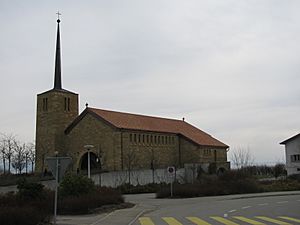Saint-Blaise, Switzerland facts for kids
Quick facts for kids
Saint-Blaise
|
||
|---|---|---|
|
||
| Country | Switzerland | |
| Canton | Neuchâtel | |
| Area | ||
| • Total | 8.86 km2 (3.42 sq mi) | |
| Elevation | 440 m (1,440 ft) | |
| Population
(Dec 2020 )
|
||
| • Total | 3,258 | |
| • Density | 367.72/km2 (952.4/sq mi) | |
| Demonym(s) | Saintblaisois | |
| Postal code |
2072
|
|
| Surrounded by | Cornaux, Cressier, Cudrefin (VD), Enges, Hauterive, Marin-Epagnier, Neuchâtel, Thielle-Wavre | |
| Twin towns | St. Blasien (Germany) | |
Saint-Blaise is a town in the canton of Neuchâtel in Switzerland. It's a municipality, which is like a local government area.
Contents
History of Saint-Blaise
Saint-Blaise was first mentioned way back in 1011, but it was called Arins then. Later, in 1209, it got the name Sanctus Blasus, which is where "Saint-Blaise" comes from. It used to have a German name, St Blasien, but that name is not used anymore.
Geography and Nature
Saint-Blaise covers an area of about 8.9 square kilometers (3.4 square miles). A big part of this land, about 52.4%, is covered by forests. About 26% is used for farming, growing crops or for pastures where animals graze.
Around 20.9% of the land has buildings or roads. A small part, 0.6%, is made up of rivers or lakes, and 0.2% is land that can't be used for anything.
The town is located at the bottom of a mountain called Chaumont. It also sits along the beautiful Lake Neuchatel. Until 2018, Saint-Blaise was part of the Neuchâtel district, but now districts are no longer used in the canton.
Town Symbol: The Coat of Arms
The official symbol, or coat of arms, of Saint-Blaise is quite interesting. It shows Saint Blasius, a saint, on one side. He is wearing silver clothes with gold decorations. He holds a golden staff and a black comb. On the other side, the shield is split into two parts. The top part is blue with a golden cross, and the bottom part is silver with a black mill wheel.
People and Population
Saint-Blaise has a population of about 3,122 people. In 2008, nearly 20% of the people living there were foreign nationals. Over ten years, from 2000 to 2010, the population changed a little. It decreased slightly due to people moving away but increased because of births.
Most people in Saint-Blaise speak French as their main language, about 82.5%. German is the second most common language, spoken by about 7.8% of the population. Italian is spoken by about 3.5%.
In 2008, the population was almost equally split between men and women. About 19.4% of the people living in Saint-Blaise in 2000 were actually born there. Many others were born in the same canton or elsewhere in Switzerland.
About 21.7% of the population are children and teenagers (0–19 years old). Adults (20–64 years old) make up 61.1%, and seniors (over 64 years old) are about 17.3%.
In 2000, there were 1,337 homes in Saint-Blaise, with an average of 2.3 people living in each home. Most apartments were lived in all year round.
The population of Saint-Blaise has changed over time:
- In 1750, there were 597 people.
- By 1850, it grew to 1,056 people.
- In 1900, the population was 1,650.
- By 1950, it reached 1,859.
- In 2000, the population was 3,117.
Important Landmarks
The entire old village area of Saint-Blaise is recognized as an important Swiss heritage site. This means it has special historical or cultural value that needs to be protected.
Economy and Jobs
In 2010, the unemployment rate in Saint-Blaise was 4.2%. This means a small percentage of people looking for work couldn't find a job.
Many people in Saint-Blaise work in different areas:
- Primary sector: A small number of people (28 in 2008) work in farming or forestry.
- Secondary sector: About 375 people work in this sector. This includes jobs in manufacturing (making things), mining, and construction (building things).
- Tertiary sector: This is the largest sector, with 898 people working here. These jobs include sales, transportation, hotels, restaurants, information technology, finance, science, education, and healthcare.
In 2000, many people who lived in Saint-Blaise traveled to other towns for work (1,252 people). Also, 993 people traveled into Saint-Blaise for work. Most people used private cars to get to work, while some used public transportation like trains.
Religion in Saint-Blaise
Based on information from 2000, many people in Saint-Blaise belong to Christian churches. About 31.2% were Roman Catholic, and 39.6% belonged to the Swiss Reformed Church. A smaller number of people belonged to other Christian churches, or to other religions like Islam or Judaism. About 21% of the population did not belong to any church.
Education and Schools
In Saint-Blaise, many adults have completed higher levels of education. About 36.9% have finished upper secondary education, and 20.2% have gone on to university or other higher education schools.
In the canton of Neuchâtel, most towns offer two years of kindergarten, which is not mandatory. After that, there are five years of mandatory primary school. Then, students go to larger secondary schools for four more years.
Saint-Blaise has kindergarten classes that are shared with the nearby town of Enges. In the 2010-2011 school year, there were 64 kindergarten students and 167 primary school students.
Some students from Saint-Blaise travel to other towns for school, and some students from other towns come to Saint-Blaise for their education.
Getting Around: Transportation
Saint-Blaise has two train stations, making it easy to travel.
- St-Blaise CFF is on the Jura Foot line.
- St-Blaise-Lac is on the Bern–Neuchâtel line.
Trains run frequently, often every hour or more. You can easily travel to cities like Bern, Biel/Bienne, Fribourg, and Neuchâtel from Saint-Blaise.
See also
 In Spanish: Saint-Blaise (Neuchâtel) para niños
In Spanish: Saint-Blaise (Neuchâtel) para niños







